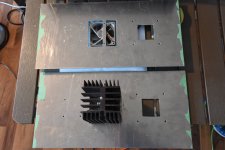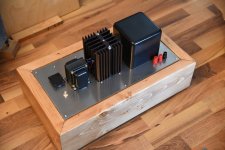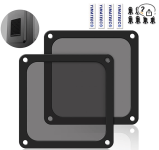I'm going to be ordering a class d amp board from Aiyima to power a passive subwoofer I have. How would you guys go about putting this in an enclosure? I've built and bought diy enclosures before for small class d modules, but not for an amp where heat can be a big issue. I'm looking for ideas and/or tips on putting something like this board into an enclosure. Thanks

The pictures of the amplifier board shows power output for a fan, so the question would be - is the heatsink itself sufficient to dissipate the heat without a fan? If a fan is required, then it is easy to place the amp in an enclosure with a fan.
Otherwise, for passive cooling, the heatsink works best if the fins are oriented vertically and there is free flow of air from below and exiting at the top. In that case, if you're handy working with aluminum, it's not too difficult to fabricate a custom enclosure using aluminum angles and plate.
But the first thing that needs to be determined is whether passive cooling is sufficient or is a fan necessary.
Otherwise, for passive cooling, the heatsink works best if the fins are oriented vertically and there is free flow of air from below and exiting at the top. In that case, if you're handy working with aluminum, it's not too difficult to fabricate a custom enclosure using aluminum angles and plate.
But the first thing that needs to be determined is whether passive cooling is sufficient or is a fan necessary.
I remember reading that it does require a 24v fan(or 2 12v) and that they should blow from the amp side towards the PSU side. They have an older version that comes with a square heatsink with cooling fins on the inside and a fan mounted to the end. If I put it in an aluminum enclosure should I mount the fans on the heatsink or can I mount 2 to the enclosure in a push/pull scenario?
It doesn't take much airflow to transfer heat away from a heatsink. There are apps on the net that will calculate the heat dissipation of a heatsink with or without airflow.
Fans work best by blowing air through the heatsink in parallel to the fins. The fan does not have to be mounted on the heatsink. Two small fans blowing would be better than push pull. Make sure that the case has sufficient vent holes for air to come in and vent out.
Fans work best by blowing air through the heatsink in parallel to the fins. The fan does not have to be mounted on the heatsink. Two small fans blowing would be better than push pull. Make sure that the case has sufficient vent holes for air to come in and vent out.
There are other options, but a very popular cooling setup for similar long horizontal fin heatsinks is to blow air from a back panel mounted fan into the center, air will naturally flow right and left guided by fins, and exit outside through exit holes punched in cabinet.
Slightly rusty MaxWatt B300

Seen from behind, notice fan and exit holes:

Similar idea: injecting (lots) of fresh air aimed at heatsink center, letting fins guide air flow outwards.
Simple and practical solution, I see it all the time.

Slightly rusty MaxWatt B300
Seen from behind, notice fan and exit holes:
Similar idea: injecting (lots) of fresh air aimed at heatsink center, letting fins guide air flow outwards.
Simple and practical solution, I see it all the time.
As an example illustrating the efficiency of fan cooling, I built a class A amplifier where the output device dissipates 85 watts continuously and the single transistor is mounted on a 4 inch x 4 inch x 5 inch long heatsink. I used an 80mm diameter quiet 12 volt computer fan to blow air through the heatsink and the heatsink just gets to the warm, but not hot state. So it doesn't take much air flow.
Attachments
Thanks for the help guys. I think I'm going to use 2 12v fans run in series vs 1 24v fan since I already have them. I plan to either use an enclosure off Amazon made from steel/plastic or fabricate my own using abs plastic sheet, wood, and aluminum angle iron for the corners. The Amazon enclosure already has venting which is something I don't think I'll be able to do myself and have it look good.
- Home
- Design & Build
- Construction Tips
- Amp enclosure


